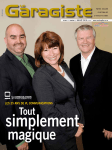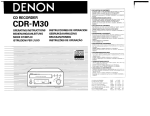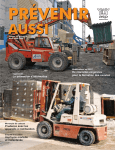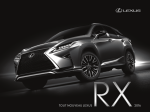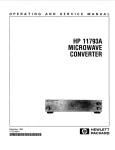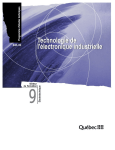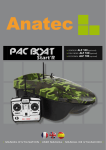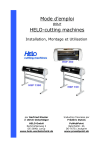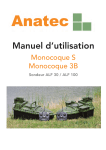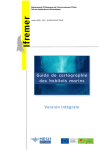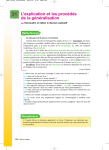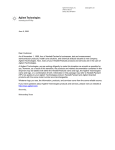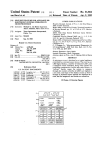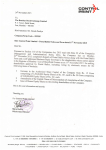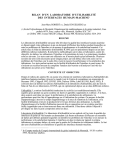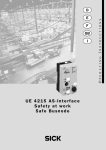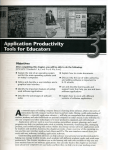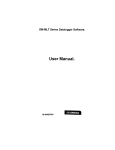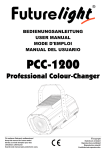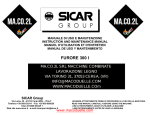Download Hydrographie Information Processing System
Transcript
Service
hydrographique
du Canada
°
FO
lil lill~~lmi11mi1i11ï1 ~1l ii~1iièque
14026 122
Région du Québec
/
QU EBE C
RAPPORT DE MISSION
MATTHEW TRIALS
DU 2 NOVEMBRE AU 20 NOVEMBRE 1991
ANDRE GODIN, HYDROGRAPHE
VK
594
G62
Pêches
et Océans
Fisheries
and Oceans
Canada
;g y&&?
~
,./ ':"\ ~.-.
,''
'<···
r
l''· "v " ' vC -LI),; ~
1
B/B LfOT:it CUE
",,,.
-;~,
.,._.
,-<'
Ra
rt de mission : Matthew Trials et visite
Du 2 au 20 novembre 1991
Conception Bay (T. -N.) et Dartmouth (N.-É.)
par André Godin
C'4111 MON T-JOU
. .10.
~
Une autre partie de ces essais consistait à faire les tests · préliminaires
du système de traitement de données denses HIPS (annexe C), que
développe le Ocean Mapping Group de l'Université du NouveauBrunswick conjointement avec la firme Universal Systems Ltd. Ce
système de traitement sera acquis par le Service hydrographique du
Canada afin de traiter les données provenant des systèmes
d'acquisitions aéroportés LIDAR; multitransducteurs Navitronic (Sweep)
et multifaisceaux SIMRAD. Les essais du DOLPHIN et les tests (beta) du
HIPS font partie des projets B et D du programme COMS (Canadian
Ocean Mapping System) développé et géré par Gerard Costello.
Du 2 au 4 novembre
• Installation de l'équipement d'enregistrement et de traitement des
données par la mise en réseau ethernet (LAN) de trois ordinateurs SUN
Sparkstation II. Les branchements, la configuration des systèmes et
l'assujettissement de ces appareils ont été effectués par le personnel de
UNB (University of New-Brunswick) et USL (Universal Systems Ltd)
ainsi que par des techniciens de BIO (Bedford Institute of
Oceanography).
vK
cf1 .
l7(vl
c-< li:>
,, - PËCHES <-'
Le rapport qui suit se réfère au Plans for MATTHEW Trials dont une
copie se trouve à l'annexe A du présent document. Des essais de
!'échosondeur multifaisceaux SIMRAD EMlOO, installé sur le CSS
Matthew, ont eu lieu à Terre-Neuve durant les deux premières
semaines de novembre. La proximité des tests a permis à la frrme GeoResources Inc. (GRI), qui met au point l'acquisition de données
hydrographiques à partir d'écho-sondeurs multifaisceaux installés sur
les semi-submersibles DOLPHIN, d'effectuer leurs essais avec le
Matthew comme bateau mère.
2 Sparkstation II GS pour le traitement avec 96 Mo RAM;
3 disques durs de 669 Mo chacun et 1 disque dur interne de
210 Mo; 1 lecteur optique; 1 lecteur Exabyte; 1 lecteur de bande
de 1/4" et 1 lecteur de disquette de 3 1 /2".
Le système
d'exploitation est UNIX et les logiciels de traitement sont HDCS
(Hydrographie Data Cleaning System) et un module de CARIS pour
la présentation des données, le tout fonctionnant sur X-windows et
Motif.
.
.
~
ç,~""
·""'
2
1 Sparkstation II GX pour l'enregistrement des données du
EMlOO avec 32 Mo Ram; 1 disque dur Wren VII de 1,2 Go; 1
disque dur interne de 210 Mo et 1 lecteur de bande de 1/4". Le
système d'exploitation est UNIX et le logiciel d'enregistrement est
MERMAID (SIMRAD) fonctionnant sur X-windows et Motif.
• Installation, par l'équipe de GRI, de la console de contrôle du
DOLPHIN dans la timonerie, des systèmes de communication entre le
Matthew et le DOLPHIN ainsi que la station GPS à terre. Installation de
l'unité de l'opérateur du EMlOO du DOLPHIN ainsi que du microVAX 31 OO et d'une unité ISAH pour la navigation. Installation du
système de positionnement DGPS à bord (Magnavox 4200D-B).
• Pour un aperçu détaillé, consulter les diagrammes, en annexe B,
décrivant la configuration de l'équipement.
• Durant ces trois jours, je me suis occupé d'installer le marémètre
TMS-1000 - équipé d'un diaphragme - sur le quai de Long Pond et
d'en faire les essais. De plus, j'avais la charge de tester et de rendre
opérationnel le vélocimètre navitronic SVP-1 et de relier le moniteur
(SVM-1) aux deux unités d'opération EMlOO du Matthew et du
DOLPHIN grâce à un câble en Y conçu par GRI; vérifier le bon
fonctionnement du EMlOO du Matthew et me familiariser avec les
nouveaux systèmes; effectuer un premier Patch-Test Matthew/DOLPHIN
en observant les erreurs angulaires d'alignement (roll & pitch offsets) à
l'aide des fonctions de calibration de l'unité de contrôle de la qualité
(QA unit). La présence d'erreurs en roulis et tangage (et peut être en
temps) est clairement apparue lors de cette première étape de
calibration; des détails sur la calibration du EMlOO du Matthew se
retrouvent dans l'annexe D.
Du 5 au 15 novembre
• Un autre Patch-Test, ainsi que des lignes en eau profonde ont été fait
le 5 novembre alors que les hydrographes de la région Scotia-Fundy
arrivaient. Des modifications et de la programmation sur le logiciel
HDCS ont été nécessaires afin de traiter les données. Ce logiciel étant
encore en développement, nombre de fonctions n'étaient .pas encore
accessibles ce qui obligeait Leonard Slipp, concepteur de ce système
(UNB), à insérer de façon interactive les données dans le HDCS et ceci
à plusieurs étapes du traitement; en plus de répondre à différentes
demandes spéciales, inhérentes à la bonne marche des opérations.
Plusieurs algorithmes de traitement ont dû être modifiés ou repensés,
en vue d'obtenir des positions, corrigées pour les mouvements du
navire et interpolées lors de la fusion. D'autres algorithmes devaient
être établis pour corriger les erreurs d'alignement.
• Des lignes régulières de sondage ont ensuite été effectuées,
simultanément avec le DOLPHIN, au-dessus d'un site (testbed)
préalablement sondé avec le FCG Smith. Mon travail consistait à
3
entraîner les hydrographes aux opérations d'acquisition des données
avec le EMlOO. J'étais en outre, responsable, avec Mike Lamplugh. du
traitement des données du Patch-Test et de l'entraînement des
hydrographes sur les systèmes de traitement. De plus. j'ai effectué une
étude comparative des données du vélocimètre et de la sonde STD-12.
pour laquelle Alvin Hayes (GRI) a mis au point un programme d'édition
et de "reformatage" des données, et dont j'ai ramené copie.
Finalement. je devais m'occuper de récupérer les données de marée.
recueillies par le TMS-1000. mais ce dernier ne fonctionnant pas
adéquatement. ce sont les données du TMS-50 qui ont servies à réduire
les sondages.
• Des visites de différentes sommités ont eu lieu durant les essais. dont
les directeurs régionaux du SHC. des représentants de la U .S. Navy ainsi
que d'autres personnes de UNB. BIO et du MPO à Ottawa. Gerard
Costello faisait alors le tour des installations ainsi qu'un exposé sur les
étapes et les réalisations du programme COMS. Leonard Slipp de UNB
et John Smart de USL ont effectué des démonstrations du HDCS et du
module CARIS du système HIPS.
• Mis à part les essais. ma tâche consistait à accumuler toute
information pertinente en vue de l'installation du EMlOOO sur le F.G.
Creed. Jim Wilson. technicien en électronique à BIO, a participé aux
cours donnés par SIMRAD sur l'installation et la maintenance des
EMlOO ainsi qu'à l'installation de ces systèmes sur le Creed et le
Matthew; il est une personne-ressource dans ce domaine. Gerard
Costello est la personne clé pour les contrats signés avec SIMRAD, ainsi
que l'inventaire et la distribution des équipements.
Du 18 au 20 novembre
• Durant ces trois jours, j'ai rencontré les personnes responsables de
l'équipement du EMlOOO et ai fait l'inventaire de cet équipement.
• Je me suis entretenu avec John Gillis de SIMRAD Mesotech afin
d'obtenir des informations complémentaires et des éclaircissements
sur certains points. En plus de différents documents. j'ai ramené une
bande vidéo sur l'installation d'un EM12, similaire aux autres
échosondeurs multifaisceaux.
• J'ai effectué une courte visite aux locaux de Sirius Solutions afin
d'assister à une démonstration de leur système de traitement et pour
poser plusieurs questions sur les ordinateurs Silicon Graphies.
4
Problèmes rencontrés
Positionnement : une ou plusieurs positions semblables mais ayant un
temps différent se succédaient dans les fichiers de positions du
Matthew, sans pour autant les voir graphiquement
(chevauchement). Le problème fut résolu par GRI en changeant la
séquence d'émission des télégrammes de positions sortant du GPS.
Calibration : des "bugs" sont présents dans les fonctions de calibration
du QA unit; i.e. on ne peut refaire les calculs de calibration pour le
roulis. De plus, il y a ambiguïté dans le manuel de l'opérateur quant
au signe que prend les données de roulis et de tangage [page 1.2
(P2343/0) et page 14 (P2361/0)]. Il n'y a aucune indication
précise sur le sens (erreur ou correction) que doit prendre les roll
et pitch offsets dans l'unité de l'opérateur. Les versions des
systèmes ont changé mais leur documentation est toujours aussi
pauvre, sinon pire!
Stepper motor : le moteur qui contrôle le système de stabilisation en
tangage s'est encore, à plusieurs reprises, arrêté. Malgré le fait
que le transducteur EMlOO du Matthew a été installé avec une
rotation de 180°, comme le préconisait la compagnie SIMRAD, ce
problème est toujours présent.
Vêlocimètre : les données du vélocimètre contiennent parfois des
valeurs erronées qui peuvent être détectées sur l'unité de
l'opérateur du EMlOO. Une fois que les données sont transférées
du moniteur (SVM-1) à l'unité de l'opérateur, elles sont perdues et
il faut refaire une saisie pour réintroduire les données.
TMSlOOO : en premier lieu, les données de marée dérivaient des
valeurs réelles et des véri{ications régulières nous obligeaient à
recalibrer le marémètre. A la fm des essais, il était impossible
d'accéder au menu principal du programme USER, affichant le
message «Introduction This version is in ROM Hit any key» ce qui
nous retournait à l'étape précédente.
Note : les problèmes rencontrés sur le EMlOO ainsi que des
commentaires, ont été transmis à la compagnie SIMRAD par Art
Parsons (BIO) et dont une copie se trouve à l'annexe E.
Recommandations
Positionnement : tout système de positionnement relié au EMlOO ou
EMlOOO, devrait, avant les opérations d'acquisition, subir un
monitoring complet en vue de déterminer s'il y a duplication de
5
r
positions ou erreur en temps entre la mesure d'une position ·et la
mesure des profondeurs.
Calibration : obtenir de SIMRAD des versions "débugés" des systèmes et
une documentation claire et détaillée. Suivre la procédure de
calibration que je soumets dans mon rapport sur la calibration
(annexe D).
Stepper motor : utiliser un transducteur fixe et sonder par mer pas trop
agitée ou obtenir une solution par SIMRAD.
Vélocimètre : faire une vérification systématique des· données de
vélocité sur l'unité de l'opérateur du EMlOO et enregistrer les
données du moniteur (SVM-1) sur un petit ordinateur HP (comme
décrit dans le manuel d'opération) avant de transférer les données
dans le EMlOO.
TMSlOOO: transmettre ces informations à SOCOMAR.
Conclusion
Malgré les petits problèmes rencontrés, ce qui est, tout compte fait,
normal face à l'implantation de systèmes aussi complexes, les essais
conjoints du Matthew et du DOLPHIN se sont admirablement bien
déroulés. Les deux véhicules ont effectué plusieurs lignes de sondages
simultanément et le prétraitement des données recueillies a démontré
que les deux systèmes fonctionnent adéquatement et pourront être
utilisés pour des levés de production.
Finalement, j'aimerais souligner l'excellent travail de la compagnie G~o
Resources Inc. qui a su rendre l'entreprise aussi efficace qu'attrayante
ainsi que le support exceptionnel de Leonard Slipp, pour tous les
"extra" sans lesquels l'opération aurait été fastidieuse sinon,
compromise.
ANNEXE A
_.
r
Plans for MATIHEW Trials
HIPS data processing and MATTHEW/DOLPHIN/EMlOO
Conception Bay, NFLD.; 1-15November1991
Prepared by G. Costello
All the key participants in the trials have been identified. The
following describes the work planned during the trials and lists the
responsibilities of each participant. These are the final plans; future
correspondance will be in the form of updates on specific items or
discussions during our weekly conference calls.
Summary
The objectives of these MATTHEW trials are:
1). To field test the new UNB/USL data processing package "HIPS";
2). To conduct trials on the MATIHEW EMlOO system in preparation for
next field season;
3). To conduct a simultaneous MATTHEW and DOLPHIN EMlOO survey;
4). To get an EMlOO data set (MATTHEW) of the test site for comparison
with other data sets.
The trials are scheduled from 1to15 November 1991 at the DOLPHIN
test site in Long Pond,Conception Bay, about 30 km west of St. John's.
During the trials the MATTHEW will be working out of Long Pond. Refer to
the attached chart. Operations will be daily; with the MATTHEW departing
Long Pond in the morning and returning that evening. The ship will
continue to work later in the evenings if necessary to complete the survey
work.
On 1 N ovember the MATTHEW will be docked in St. John's harbour.
USL, UNB , GRI and BIO technical personnel will arrive on 1 November to
be gin equi pment installation; CRS hydrographers will arrive on 5 ·
November.
There should be 3 vehicles available; GRI, J. Wilson and M. Ruxton.
G. Costello will coordinate the trials; he can be reached at (709)7390918; FAX (709) 739-1538. Preparation for the trials will be reviewed each
week on Fridays; participants will be contacted regarding their state of
readiness.
·
Following the trials, UNB students will join t he MATTHEW for t he
trip to Halifax to get hands on experience with the EMlOO and "HIPS" data
processing while at sea. There will be 5 bunks available for students on the
MATTHEW.
This is a brief summary, mainly to clarify dates.
lNov.
MATTHEW will be docked in St. John's. Ready for equipment
installation by 1800 hr.
_.
Jim Wilson, John Smart, Leonard Slipp and André Godin arrive;
GRI personnel are in St. John's.
2-4 Nov.
Equipment installation and initial calibration in St. John's/Long
Pond.
5 Nov.
M. Lamplugh, M. Ruxton and G. Rodger arrive and join
MATTHEW. J. Manning and D. Street join MATTHEW.
5-15 Nov.
Daily sea trials from Long Pond.
11-15 Nov
Visitors are welcome to view the sea trials.
16 Nov.
Unload equipment from MATTHEW (Long Pond or St. John's); ship
ready for departure to Halifax late that evening.
HIPS Trials
USUUNB wilI install "HIPS" on the MATTHEW and demonstrate its
functionality using EMlOO data collected by MATTHEW and DOLPHIN.
MATTHEW EMlOO Trials
The following tests will be conducted:
•Patch test
• Accuracy/repeatability tests
• Shallow water test
• Deep water test
• Mechanical pitch test
A regular EMlOO survey of the test bed area will also be completed~
The MATTHEW EMlOO is ready for operation. New versions of operator
console software and transceiver eproms have arrived from SIMRAD and
will be installed by Jim Wilson. He will be on the MATTHEW for the
duration of the trials.
DOLPHIN -MATTHEW Simultaneous Suryey
These trials will be carried out in cooperation with Geo-Resources
personnel. GRI have prepared detailed plans and are responsible for the
operational aspects of DOLPHIN and positioning for both MATTHEW and
DOLPHIN.
•
P os1•t•1on1ng
Geo-Resources are responsible for supplying the positioning.
For "MATTHEW Only" Trials
Primary:
DGPS and ISAH
Secondary: Single GPS and ISAR
Tertiary:
MRS 111 and ISAR
For MATTHEW/DOLPHIN Trials
Primary:
DGPS and DOLPHIN Navigation system
Secondary: DGPS and ISAR for MATTHEW
DGPS and DOLPHIN Navigation system for DOLPHIN
Tertiary: · Single GPS and ISAR for MATTHEW
Single GPS and DOLPHIN Navigation system for DOLPHIN
There may be short periods of GPS outages in the mornings but as of
noon local time GPS coverage will be good.
Sound Yelocitv Data
Sound velocity or STD profiles will be collected as required during the
trials. The Navitronic SVP-1 on Joan from Québec and the SVP-16 on the
MATTHEW are available. As a backup the STD-12 on loan from Québec
region will be available.
Tidal Data
A TMS 50 and an Ottboro are installed at Long Pond and maintained
by GRI. Data will be available daily.
Sun Workstation Configuration
Two Sun workstations are required for the trials; one to control the
MATTHEW EMlOO data logging using the new Simrad Mermaid-D
software and one for the 'HIPS' data processing. USL will ship the -SparcStation 2GS to St. John's already configured with "HIPS" and a
SparcStation 2GX from CRS, BIO will be installed for Mermaid-D logging.
The existing SparcStation 2GS on the MATTHEW will be used as backup.
Mermaid software has arrived from SIMRAD and is being installed at BIO.
The MATTHEW EMlOO operator console, DOLPHIN EMlOO operator
console, the Mermaid datalogger SparcStation and the 'HIPS' SparcStation
will be connected via ethernet. The Mermaid SparcStation will log the data
temporarily (daily) on its disk and then as required the datais transferred
to the 'HIPS' SparcStation main disk for processing.
DOLPHIN/EMlOO Installation on the MATTHEW
The following equipment needs to be installed on the MATTHEW for
the simultaneous DOLPHIN-MATTHEW operations:
• DOLPHIN operator system; including operator console, navigation
computer and radio.
• EMlOO system; including operator console, QA unit and data logger.
• 3 antennae: GPS receiver; HF radio for GPS corrections; and DOLPHIN
telemetry link.
The first two items will be installed in the hydrographie chart room
and/or on the port side of the bridge. The EMlOO computers are individual
components (not housed in the large blue cabinets). The antennae will be
mounted on the flying bridge or mast of the ship with cables to the chart
room or bridge.
A reconnaisance visit to the MATTHEW was made on 23 September
to discuss this installation.
Personnel/Accommodation
The following personnel will participate in the trials and will stay
aboard the MATTHEW:
Leonard Slipp from UNB; Wing Wong and John Smart from USL; Gerard
Costello, Mike Lamplugh, Glen Rodger and André Godin from CHS.
The following personnel will stay ashore:
Mike Ruxton, J oe Manning and Dave Street from CHS; Jim Wilson from
BIO; Derrick Peyton, Alvin Hayes, Joe Grzetic, Jeff Head and Trevor
Johnson from GRI.
GRI, Jim Wilson and Mike Ruxton will have vehicles.
Visitors will be scheduled between 11-15 November only, unless these
dates are a problem for them.
Confirmed visitors to date include:
Three personnel from US Naval Oceanographic office; 7 November; mainly
for a DOLPHIN demo from GRI.
Ted Maher and Don Dinn from BIO; 13-14 November.
D. Nicholson from CHS; 7-11 Novem.ber
D. Wells and/or C. Ware from UNB; 10-11 Nov.
Mike Crutchlow from CHS; sometime between 8-15 Nov.; to be confirmed.
John Warren from CHS; 13-14 Nov.
W e expect CHS personnel from other regions but names and dates
are not confirmed yet. Please call G. Costello to confirm your visit. The ship
can handle a maximum of 6 visitors on a day trip. All visitors will stay
ashore overnight, but meals will be provided while they are on board during
the day.
Suggested hotels are: St. John's hotel (709-726-4980) or Travellers Inn
(709-722-5540); both on Kenmount Rd./Route 1. To get to Long Pond wharf
from St. John's airport: go east on Portugal Cove Rd., Route 40 for 2 km;
then west on Prince Phillip Dr. for 4 km.; then west on Kenmount Rd.,
Route 1for10 km.; then take exit la; then west on Pitt Memorial Dr. for 7.5
km.; then west on Route 60 for 3 km., to the wharf road. It's about 30
minutes.
DAILY SCHEDULE
There will be a daily work plan posted on board the MATTHEW each
evening prior to the next day' s work.
1-3 Noyember
Mobilization. Installation and testing of equipment .on MATTHEW.
L. Slipp, J. Smart, J. Wilson, A. Godin and GRI personnel will be involved.
MATTHEW will be docked in St. John's at first and then go to Long Pond,
likely on 3 Nov.
Monday. 4 Noyember
MATTHEW EMlOO tests:
• patch test and other necessary calibration prccedures.
Complete HIPS and DOLPHIN equipment installation.
Tuesday. 5 NoyeD1her
CRS Hydrographers arrive in am.
EMlOO operator training
Begin MATTHEW testbed survey to collect data for HIPS
HIPS testing.
Wednesday. 6 Noyember
Begin MATTHEW-DOLPHIN survey
HIPS testing.
Thursday. 7 Noyember
MATTHEW-DOLPHIN survey
Demonstration for US Navy.
HIPS testing.
Friday. 8 Noyember
MATTHEW-DOLPHIN survey
HIPS testing.
Saturday. 9 Noyember
Matthew EMlOO tests:
•patch test
• accuracy/repeatibility tests
• shallow water test
• deep water test
• mechanical pitch test
HIPS testing.
Sunday. 10 Noyember
Matthew EMlOO tests:
•patch test
• accuracy/repeatibility tests
• shallow water test
• deep water test
• mechanical pi tch test
HIPS testing.
Montlay. 11 Noyember
Matthew EMlOO tests:
•patch test
• accuracy/repeatibility tests
• shallow water test
• deep water test
• mechanical pi tch test
MATTHEW EMlOO testbed survey.
HIPS testing.
Tuesday. 12 Noyember
MATTHEWEMlOO testbed survey.
HIPS testing.
Wednesday. 13 Noyember
MATTHEWEMlOO testbed survey.
MATTHEW-DOLPHIN survey
HIPS testing.
Thursday. 14 Noyember
MATTHEW EMlOO testbed survey.
MATTHEW-DOLPHIN survey
HIPS testing.
Friday. 15 Noyember
MATTHEW EMlOO testbed survey.
MATTHEW-DOLPHIN survey
HIPS testing.
Saturday. 16 Noyember
Demobilization completed by 1800 h and ship ready for departure to
Halifax.
The above work schedule is subject to change depending on progress,
weather, and visitors plans.
•
Plans for MATTHEW Trials
Indiyidual
Respons ibilitiesllssu~
Leonard Slipp and John Smart
• Write up a brief description of HIPS for distribution during trials.
• Configure the MATTHEW SparcStatiori including reinstall the OS to
ensure 'HIPS' will function; configure the software aspects of ethernet.
• Hardware:
solve GX board issue/Done
HP paint jet plotter/Done
• Software:
Reconfigure MATTHEW GS for trials
Re-install Sun OS on MATTHEW GS; 1-2 days
Ensure Sufficient Swap space
Disk partitions of sufficient size; = 300mb
Test data transfer from Mermaid GX to HIPS GS
Network configuration & testing
•HIPS software: install X-Windows & Motif (bring libraries
·
& debugging? software); 1 day
install UNB HDCS and USL HIPS
recompile system
bring HDCS directory and Conception Bay &
Anticosti EMlOO data; tape recorder
• Transfer HDCS data (Position-Dep~h file) to HIPS/CARIS/Done
• Assemble required HIPS modules to one package; 7.1, 7.2, 7.3,
7.4, 7.5, 7.6, 7.7, 7.8, 7.9; 8.1, 8.2, 8.3, 8.4
• Identify USL/ UNB personnel/Done
• Confirm which plotter/printer will be used for Screen dumps/Done
• Will Morton code searching be demonstrated?
° Flagged data points from HDCS must be passed to HIPS/CARIS
• Bring tape recorder and video camera.
J. Wilson
0
Send latest version of ISAR to GRI; to output lat, long.
• solve grapr.aics terminal request (VT240 or 340 or 330)
• deliver and install the Mermaid 2GX on the MATTHEW
• configure the MATTHEW EMlOO operator console, DOLPHIN EMlOO
operator console, Mermaid GX and HIPS GS on ethernet. Set up computer
addresses/hostid' s.
• Connect a terminal (VT320) to the HIPS GS.
• Bring Draftmaster II to St. John's
• Check on generator at BIO; 1 kw/Done
• Send latest EMlOO software and eproms to GRI/Done
• Install new software and eproms on MATTHEW EMlOO
• Check on old DOLPHIN engine at BIO; Leaman 4 cylinder.
• Transducer ram operation.
S. Forbes
• Configure the SparcStation 2GX at BIO (including new disk) for
Mermaid/Done
• Install and test Mermaid software on GX computer at BIO/Done
• Send Mermaid logged data to L. Slipp at UNB
CHS Hydrographers: M. Lamplugh. M. Ruxton. G. Rodger. A. Godin. J.
Manning and D. Street
• Read EMlOO operator manual; May 91 version
• Read Mermaid documentation
• Get some "hands-on" the EMlOO in J. Wilson's shop.
• M. Lamplugh and A. Godin goto UNB on 24-25 October.
• Inform G. Costello of anything missing in preparation for trials.
• Read/review UNB report 'Requirements Analysis and Conceptual Design
of Data Cleaning Tools for Large Bathymetric Data Sets', November 1990.
• Get copies/plots of all historical data sets of the test site in Conception Bay; in
particular CREED Elac and SMITH (Lamplugh and Ruxton).
• Prepare a 'HIPS Feedback' sheet for use during trials (Lamplugh).
• During trials hydrographers will alternate between EMlOO operation and
HIPS processing.
• Send the Navitronic SVP-1 to G. Costello in St. John's (A. Godin).
GRI
• Procure and test DGPS system, including HF radio link prior to trials.
• Supply Positioning for MATTHEW and DOLPHIN
• Configuration and Installation of all DOLPHIN equipment on MATTHEW
• Plan details of MATTHEW/DOLPHIN survey.
Alvin Hayes
• Complete DOLPHIN EMlOO patch test and calibration prior to trials
• Prepare TMS tide data for input into HIPS; contact L. Slipp.
• Prepare back up logging in case Mermaid don't work.
• Provide EMlOO operator training to hydrographers on 5 November.
• Tide gauge operation
• Geodetic control
• SVP/STD operation and interface to EMlOO
• ISAR operation
Joe Grzetic and Trevor Johnson
• Install new EMlOO software and eproms in DOLPHIN system.
• Interface MX4200 to ISAR and EMlOO.
Julian Goodyear/Charlie Stirling
The following will remain on MATTHEW:
• 2 Draftmaster II's
• 1 VT320 and 1 VT330
• 1 SVP-16
• sufficient plotter pens, paper and mylar.
• SUN mauuals; EMlOO manuals; TSS manual.
Gerard Costello
• Contact Long Pond Harbour Master/Done
• Ensure Mermaid software is delivered to BIO from SIMRAD./Done
• Check MATHEW for set of Sun/Unix manuals including System
Manager/Do ne
• Prepare information for visitors to trials.
• Submit N/M regarding trials
• Plan details of MATrHEW tests.
• Specs on all EMlOO telegrams sent to L. Slipp/Done
• Check existing computer configuration on MATTHEW and report to
USL/UNB/Done
• Check lighting on MATTHEW computer room/Done
• Prepare daily operation schedule during trials.
• Contact and alert SUN Field Rep./Done
• Get details on helicopter time/Done
• Send comments on existing HIPS menus to USL
• Prepare equipment configuration diagram and distribute/Done.
• Send list of potential CARIS bugs to USL
• Coordinate with other regions/Done.
• Prepare Cruise Plan 'B'; list of staff and next of kin; submit to Ships Division
Captain Roy Lockyer
• Get life jackets and survival suits for 15 extra people (9 day workers and 6
visitors) above the full ships' complement; this is in addition to the 7 people
occuping the scientific berths.
ANNEXE B
MATTHEW
ISAH Helm
Display
• Harris HF
Radio
•Data Modem
Rcor
MX4200D-B
la t,long
ISAH
GPS
Reciever
MATTHEW
Helm Display
DOLPHIN
SŒJ
-...---
Hcor
i.-------t
Vax3100
Navigation
Computer
DOLPHIN
Pack.et Radio
t---Pf
SVP-1
DOLPHIN
Helm Display
Equipment Configuration
MATTHEW/DOLPHIN
Trials
To "HIPS• Data Processing
Equi:pment Configuration
MA1~THEW/DOLPHIN Trials
Data. Processing Room
1
'
-:TMSlOOO
.
::• Tide data: :1--- -
::
input
.
. ...........
. . . . . . . .... .
.. ... ... . ..
.HIPS
.
:Data Processi:ng::
: •Sparc 2GS
: • 2.3 GB disk
..........
.......................................
.. .....
. . . . . . . . . ... ....
:::Line ::::::------
·io---------...1
::: Printer ::::::
Swit.ch
~~~
~~~
.-..i:vttèt
.....
( !!!:
. . . .. .... .
P2184E/2
Page 4
SIMRAD EM 100 Operator Manual • NAVOCEANO
Part 1 · System Famillarlzation
REAL TUIE Q.4 CON!Ja.E
OPERATORS CONSCU
l
a.oac·----1
RSDZ 8ERJAL UNE
POSlnON INPllT
SOUND
VELOCITY'--~-
EXTERNAL
f:
, • -... ['.<'i
\,,-
.
1
'
.
...
1--.....r
ni'
r ·-' .... '" -
WB! COMPUTER
\ •
,,, ..,,,.
'
4--+---DATA
LOQQER
COI.OUR ORAPHJC
RECORDER
'-
TRANSCEIVER
mACK PLUTTER
PREAllPURER
.......
HEAVE-ROLL • PfTCH.SENSOR
OYRO COllPAtlS - - - - - - - - '
HULL UNff
TRANSDUCER
Fig.1.2. EM 100 system units ·major assemblies
-..__,-.
Sbnrad lncorporated
0--"~'-
tTO A
ANNEXE C
HIPS
Hydrographie Information
Processing System
Functional
Description
NOVEMBER 1991
Universal Systems Ltd.
270 Rookwood Avenue
Fredericton, NB
CANADA
E3B 2M2
Tel: (506) 458-8533
Fax: (506) 459-3849
CARIS - HIPS Functional Description
CARIS - HlPS
Hydrographie Information Processing System
Functional Description
November 1991
1.0 Overview - the HIPS Hydrographie Information Processing System
The HIPS Hydrographie Information Processing System is a powerful software system
which has been designed specifically to process the very large quantities of sounding data
now being collected by multi-beam echosounders.
HIPS is designed to receive logged sounding data, automatically check the data for
blunders, automatically perform corrections, and merge data sources to produce 'clean'
soundings. The automatic processing is supported by powerful, user-friendly interactive
editors, developed specifically for swath data editing. Upon cleaning, field sheets can be
prepared and plotted using a wide range of hydrographie processing software. The cleaned
datais available for further input into, for example, hydrographie databases.
HIPS comprises the following coi;nponents:
1. Hydrographie Data Cleaning Software (HDCS)
2. Data Visualization
The Hydrographie Data Cleaning Software (HDCS) first retrieves previously
logged survey information. Systems to be supported initially include the Simrad EM 100,
the Optech SHOALS and the Navitronics SEADIG 201. HDCS processes the data globally
(ie. corrects for blunders, tides, draught, sound velocity, heave, roll, etc.) so that the
collected datais 'clean'. Fast automatic processing is supported by interactive graphies
tools. This allows the hydrographer to have full control over processing, where necessary.
Both interactive and automatic corrections work on individual data to address sounding
anomalies such as spikes and data gaps.
The cleaned soundings can then be processed and displayed via the Data Visualization
module. This module performs all tasks necessary to generate finished field sheets, which
can be plotted for presentation. The cleaned soundings are also available for inclusion in a
hydrographie database, and can be manipulated, using CARIS, for cartographie chart
compilation, design calculations for marine construction works, dredging calculations, and
for other hydrographie related requirements. (See Figure # 1 attached).
HIPS - Hydrographie Information Processing System
UNIVERSAL SYSIBMS LTD.
CARIS - HIPS Functional Description
HIPS operates on workstation hardware operating under UNIX®, in a menu driven, XWindow environment using MOTIF® as a presentation manager.
Hydrographie Information Processing System
HIPS - Processing Steps
Figure#l
CUSTOMER
SURVEY INFORMATION
Supplied
DATA
RETRIEVAL
RETRIEVES Hydrographie
Data for processing
HDCS
HYDROGRAPHIC DATA
CLEANING SOFIWARE
~
-tidci, oound vclocily, draught
- lx:avo, ràl, pitch
-nsviptiauhilU
INTERACITVE
Processing
and AUTOMATIC
- spilœ rc:moval
- dm lhiunlng
DTM PLOTS
DATA VISUALIZATION
DATA
STORAGE
HIPS - Hydrographie Information Processing System
UNIVERSAL SYSTEMS LTD.
CARIS - HIPS Functional Description
,,,...
.... #
2.0 HIPS System Description
2. 1
Hydro~phic
Data
Cleanin~
Software ŒIDCS)
The Hydrographie Data Cleaning Software (HDCS) edits the data globally (ie. corrects
for blunders, tides, draught, sound velocity, heave, roll, etc), and provides for both
interactive and automatic data corrections on individual data samples (ie. spikes, gaps,
etc.) Processing is done in a number of steps·:
2.1.1. DataRetrieval
Data Retrieval involves reading survey logging files, and writing
the data into HDCS files. The Data Retrieval portion of HIPS is
survey system dependent. In each case, a given system's data
collection characteristics dictate the ultimate product to be
displayed, stored and made available for various hydrographie
computations. (eg, if the ship's characteristics are not provided
then the associated corrections for roll, pitch and heave cannot be
applied). Data, once retrieved, is stored in seperate files for
navigation, depth,heading, heave, pitch and roll. Ali files are
indexed by time.
2.12. Preliminary Navigation Quality Control
The navigation. data is filtered and undergoes quality control. ship
positions which are not possible according to simple rules will be
automatically removed or flagged in the navigation data status word A
summary report will be produced which quantitatively describes the
results.
2.1.3. Preliminary Sounding Quality Control
This fonction automatically flags suspect soundings. The sounding QC
uses algorithms which test minimum and maximum depth, as well as
sounding slope and spike detection.
2.1.4. Interactive Navigation Editing
This module allows for full operator interaction for flagging certain
sections of a ship's track as being bad even though they are not detected
by the automatic filtering algorithm. The user will also be able to confirm
suspect navigation data as actually being bad.
2 .15. Merging of Positions and Depths
A merging fonction takes HDCS depth, navigation, tide, velocity profile,
vessel dynamics and other files to generate the Position-Depth file. This
fonction will generate a summary report describing the maximum and
minimum corrections made due to each of the above effects.
HIPS - Hydrographie Information Processing System
UNIVERSAL SYSTEMS LTD.
,....
CARIS - HIPS Functional Description
··'
2.1.6. Spatial Index Production
An optimized Position Spatial Index file for any number of given input
Position/Depth files is produced at this stage. This index file allows faster
access for subsequent retrieval of soundings from Position-Depth files.
2.1.7. Interactive Sounding Editing
An interactive graphies tool provides full operator interaction for depth
data cleaning and verification. An interactive "subset creation" tool, which
is one part of the Sounding Editor, is used to select sub-areas for editing.
Editing fonctions include tools which generate the following data to assist
in the verification process:
•
•
•
•
•
An estimated surface comprising a moving weighted average.
A standard deviation surface.
Automatic classification of soundings based on the above surfaces
Overlap visualization and summary report of coverage.
Shaded plan views, colour-coded standard deviations and depths,
layer-coloured raster.
• Plan and elevation views of soundings.
Also included are:
• Query fonctions for individual sounding attributes (including
position, sounder number, signal quality, etc.)
• Interactive fonctions to mark bad soundings
2.2 Data Display and Data Visualization
Once data has been cleaned to an acceptable level with the HDCS software, it is
available for a number of products. Following is a list of the various operations and
tools available for field sheet production.
22.1 Field Sheet Planning and Creation
A menu-based system is used to define a pattern of field sheets covering the area
of interest. Indivi<lual field sheets can also be defined. Many ellipsoids and
projections can be supported. Cartographie (INT2 standard) borders, projection
grids, geographic graticules and scale bars can be added to the template field
sheets.
2.2 .2 Rejormat from PositionDepth files
At the end of HDCS processing of a day's survey data, the cleaned soundings are
transferred into one or more field sheet files. The transfer can be limited according
to sounding attributes. For example, only soundings which have had a tide
correction, or which were not marked as 'bad' might be transferred. A choice of
additional sounding attributes, such as timestamp, accuracy factor, etc, can be
transferred.
HIPS - Hydrographie Information Processing System
UNIVERSAL SYSTEMS LTD.
CARJS - HJPS Functionat 1Jescription
2.2.3 Sounding Fi/ter
A huge number of soundings is produced using multibeam technology. The
sounding filter carries out overplot removal to suppress all but a few soundings
for display. The filter can be shoal-biased or deep-biased. The program has the
ability to maintain the original data densities in areas of interest (eg around shoals,
wrecks etc.). The reduced number of data points also allows other processing to
be carried out more efficiently.
22.4 DTM generation
The DTM Module can produce an irregular DTM using up to 500,000 soundings.
A gridded DTM can also be produced with an unlimited number of input
soundings. The gridded DTM uses a moving weighted average interpolation
fonction.
2 2 .5 Produce Contour Worksheets
Once the DTM is created, contours can be drawn and contour worksheets can be
generated. The contours may be colour-coded as demanded by the hydrographer
and labels may be interactively placed. Automatic contour labelling will be
available.
22.6 Produce Profiles Interactive/y
The DTM worksheets allow the hydrographer to define the direction of a profile
on the DTM and have it generated and displayed in X section on the screen.
Vertical and horizontal scales can be selected for feature identification.
2.2.7 Produce 3D Views
3D views based on the DTM can be generated to assist hydrographers in detecting
certain features on the seabed. The DTM can be classified by depth, slope or
aspect. Map features can be 'draped' over the DTM. For plotting on a pen-plotter,
3D grids, coloured by depth, slope or height, can be displayed and redirected to
the plotter.
2.2.8 Produce "Selected Depth Plots"
The data output mcxlule produces different plots that indicate selected soundings,
DTMs, profiles and original data.
22.9 Produce "Raster" Surface Visualization
As a by-product of the regular (gridded) DTM, a synthetic raster surface is
produced which approximates the actual surface as defined by the x,y and z
values. This surface is useful for quick plan view visualization of the surface.The
HIPS -Hydrographie Information Processing System
UNNERSAL SYSTEMS LID.
CARIS - HIPS Functional Description
appearance of the created surface is enhanced by the use of a simple lighting
model.
2.3.10 Produce "Raster" Summaries
A fonction which produces a raster surface (similar to that in 2.2.9) by "binning"
is also available. This very fast operation provides a quick assessment of survey
coverage.
23.11 Text and Symbolization
Text and symbols can be added to plots and DTM visualizations, to provide
additional information or to provide terms of reference.
For further information about HIPS, please contact Universal Systems at:
Universal Systems Ltd.
270 Rookwood Ave.
P.O. Box 3391, Station "B"
Fredericton, New Brunswick, CANADA
E3A 5H2
Tel:
Fax:
(506) 458-8533
(506) 459-3849
HIPS -Hydrographie Information Processing System
UNNERSAL SYSTEMS LID.
ANNEXE D
,H~
<I"
l
Calibration du EMlOO sur le Matthew
Du 2 au 15 novembre 1991
Conception Bay, Terre-Neuve
par André Godin
-
La méthode utilisée pour calibrer !'échosondeur multlfaisceaux EMlOO
du CSS Matthew est basée sur les procédures prescrites par le National
Oceanic and Atmospheric Administration (NOAA) dans l'article Patch
Test, a system check for multibeam sW1Jey systems. Cette méthode fut
utilisée dans le passé pour les échosondeurs multlfaisceaux des navires
Louis M. Lauzier et Frederic G Creed. Malgré le fait que les types
d'appareils utilisés par NOAA diffèrent des nôtres, la méthode du Patch
Test demeure encore la plus efficace pour déterminer les erreurs
d'alignement et de système de !'échosondeur. Une variante s'est
toutefois ajoutée à la procédure antérieurement suivie, avec l'emploi des
fonctions de calibration offertes par !'Unité de contrôle de qualité (QA
unit). Les détails sur les lignes sondées se retrouvent dans le dossier
Patch-Tests Matthew ci-joint.
Mêthodolo&fe
1) Un premier jeu de lignes réciproques (Patch-Test O) nous a permis ·
de constater, en temps réel, la présence d'erreurs d'alignement en
tangage et en roulis (pitch & roll offsets). Les fonctions de
calibration du QA unit ne nous permettant pas d'obtenir la valeur de
l'erreur en tangage - étant donné que cette dernière peut se
composer également d'erreurs en temps - nous nous sommes
contentés de déterminer, grossièrement, la valeur de l'erreur de
roulis. Cette erreur représente la différence d'alignement entre le
plan du navire et le plan de l'inclinomètre TSS-335 dans l'axe
transversal et une valeur de - 0.5° fut trouvée (voir les impressions
d'écran dans le dossier Patch-Tests Matthew). Une erreur négative
signifie que le côté tribord se trouve au-dessus du plan horizontal,
selon le manuel d'opération du EMlOO, P2343/0 page 1.2.
2) Un jeu complet de lignes réciproques et adjacentes (Patch-Test 1) a
alors été obtenu afin de déterminer, de façon précise et par le biais
du traitement (HIPS) et d'analyse, les erreurs d'alignement (roulis,
tangage et gyro) du système. Des lignes ont été sondées à des
vitesses différentes afin de vérifier la présence d'erreurs en temps.
3) L'étape suivante consistait à traiter les données et à obtenir une série
de tracés d'isobathes afm de déterminer les erreurs de tangage et de
temps, tout en appliquant une correction de+ 0.5° au roulis afin de
rendre les isobathes parallèles, permettant des mesures plus
précises.
,.
2
4) Des mesures de déplacement entre isobathes ont été effectuées sur
des copies papier, avec des données non corrigées pour le roulis et
sur écran graphique - à l'aide des fonctionnalités offertes par CARIS
- sur des lignes dont la correction de + 0.5° au roulis était
appliquée. Les mesures ont été faites sur 3 jeux de lignes (5 kn,
10 kn et 10 kn, lignes adjacentes) offrant 5 comparaisons possibles
dans le but d'obtenir la meilleure moyenne statistique de l'erreur le chiffrier électronique Lotus a été utilisé. Une moyenne de - 1.2° a
été déterminée sur un total de 400 mesures 1• Une erreur négative
signifie que l'étrave se trouve en-dessous du plan horizontal, selon le
manuel d'opération du -EMlOO, P2343/0 page 1.2. Aucune évidence
d'erreur en temps n'apparaît lors de la comparaison des valeurs de
déplacement entre deux jeux de lignes réciproques sondées à des
vitesses différentes.
5) Ensuite, il s'agissait de vérifier la présence d'erreur azimutale (gyro
offset) en comparant des lignes adjacentes sondées dans la même
direction. Aucune erreur azimutale n'apparaissait lors de cette
procédure.
6) D'autres lignes réciproques (Patch-Test 2) a alors été obtenu, avec
des corrections de - 0.5° et - 1.2° intégrées dans l'unité de
l'opérateur (OPU); sous-menu INSTALLATION MENU ... MOTION
SENSOR MENU: ROLL OFFSET & PITCH OFFSET. Une vérification
rapide de la calibration, à l'aide du QA unit, nous a montré que les
corrections étaient appliquées dans le mauvais sens, rendant les
erreurs d'alignement plus importantes encore. Cette confusion est
survenue lors de l'établissement du signe des erreurs, en fonction
des informations fournies dans le manuel de l'opérateur P2361E/O,
page 14.
7) Finalement, un dernier jeu de lignes réciproques (Patch-Test 3) ont
été obtenues avec des corrections de + 0.5° et + 1.2° intégrées dans
l'unité de l'opérateur (OPU) et les résultats, autant par le QA unit que
. par le post-traitement des données, ont démontré que ces
corrections sont exactes en sens et en magnitude.
8) Un deuxième calcul de la moyenne a été fait sur le chiffrier EXCEL
(voir tableau en annexe) et les valeurs ont été vérifiées. Une
moyenne de - 1.42° pour l'erreur de tangage a donc été obtenue et
c'est cette valeur qui doit maintenant être adoptée; i.e. d'une part il
faut utiliser les mesures faites sur les lignes corrigées pour l'erreur
de roulis (non biaisées par le déplacement des isobathes causé par
l'erreur de roulis) et d'autre part, une augmentation de l'erreur, de
1 Il est impératif de faire une moyenne sur plusieurs mesures étant donné que l'exactitude de ces mesures
repose sur la précision du système de positionnement. Le système employé sur le CSS Matthew était un
GPS en mode différentiel, de marque Magnavox (42000) avec une précision de± 5 m.
3
1.2° à 1.42°, semble plus Juste quand on observe les résiduelles sur la
surimpression des ~racés d'isobathes de deux lignes réciproques
effectuées dans le dernier patch test (3).
Ce qy.'il reste à faire
1) Retraiter les données de lignes réciproques en eau profonde, avec
une correction de + 1.42 ° pour le tangage, et déterminer de façon
précise l'erreur de roulis; i.e. l'erreur de - 0.5° avait été obtenue de
manière approximative avec les fonctions de calibration du QA unit et
une analyse statistique -sur plusieurs mesures serait plus appropriée
pour déterminer cette erreur.
2) Retraiter les données en eau profonde, avec des corrections précises
pour le roulis et le tangage, et vérifier la répétition et la performance
du système en faisant des analyses sur la zone de chevauchement
(difference DTM, contour plot, STD surface, etc.).
Recommandations
1) Obtenir des éclaircissements auprès de SIMRAD pour connaître le
vrai sens des erreurs (ambiguïté entre les sections P2343/0 page 1.2
et P2361E/O page 14 du manuel de l'opérateur) ainsi que la
signification des entrées dans le OPU (roll, pitch, gyro offsets) et
dans le QA unit (roll & gyro offsets).
·
2) Mettre au point des procédures de commandes (command files) avec
CARIS pour faire le traitement en batch (beaucoup plus rapide).
3) Une fois que les valeurs exactes des erreurs ont été déterminées, les
intégrer dans le OPU afin que toutes les corrections soient faites en
temps rêel. Ceci prend particulièrement de l'importance lors de la
correction pour la vitesse du son dans la colonne d'eau, qui est
seulement faite en temps réel. De plus, il est logique de corriger des
mesures lors de leur observation, car une correction dans le posttraitement n'agit que par une rotation des sondes autour d'un axe, en
assumant que le fond est plat, ce qui est rarement le cas.
4) Une évaluation subséquente du traitement par le HIPS m'a permis de
constater que le système ne corrige pas les données pour la
différence entre le tangage du navire (ship pitch) et l'angle que
prend le transducteur p/r au plan du navire (transducer pitch).
Toutes les données ont donc été incorrectemnt traitées et ceci
explique l'écart type relativement élevé sur les mesures de
calibration. Le retraitement total des données n'est pas nécessaire,
étant donné qu'une multitude de mesures ont été faites et que ces
erreurs seront uniformément réparties.
Il faut modifier la
programmation du HIPS afin qu'il corrige pour la différence de
tangage entre le navire' et le transducteur.
......
,
r
4
Procédures de calibration pour le EMlOO(O)
La méthode utilisée ici diffère légèrement de la procédure employée
par NOAA dans Patch Test, a system check for muitibeam survey
systems mais le patron de lignes de sondage et les formules utilisées
pour déterminer les erreurs sont les mêmes.
1) Patch test : effectuer un patch test complet (30 à 150 m de
profondeur) au-dessus d'une pente moyenne (15 à 25°) et_
déterminer, à l'aide des fonctions de calibration du QA unit, l'erreur
approximative de roulis. Ne pas oublier de faire des lignes à des
vitesses différentes pour l'établissement d'erreurs de temps . .
2) Eau profonde : faire des lignes réciproques en eau profonde (300 à
500 m), au-dessus d'une pente régulière et peu inclinée pour la
détermination de l'erreur de roulis.
3) Détermination des erreurs de tangage et de temps : traiter les jeux
de lignes réciproques, corrigées pour l'erreur de roulis trouvée lors
du patch test, et effectuer les mesures de déplacement entre les
isobathes (échelle 1:1000). Vérifier la présence d'erreur de temps
par la comparaison des déplacements sur des jeux de lignes faites à
différentes vitesses (d,es déplacements plus grands pour des vitesses
·plus élevées). S'il y a une erreur de temps, le mieux est de la
déterminer en faisant le monitoring du système de positionnement
et de retraiter les lignes avec des corrections de roulis et de temps.
Le calcul de l'erreur de tangage se fait par la moyenne de toutes les
erreurs calculées en utilisant, si possible, un chiffrier électronique,
ce qui est beaucoup plus rapide et efficace. Les mesures de
déplacement doivent se faire à l'aide du module CARIS du HIPS car
il permet la présentation des contours (DTM régulier) avec le tracé
des positions (ship's track), la mesure des distances avec un curseur
et le zooming, ce qui augmente de beaucoup la précision des
mesures.
4) Détermination de l'erreur de roulis : traiter les lignes réciproques en
eaux profondes avec les corrections de tangage et de temps s'il y
en a. Mesurer et calculer l'erreur de roulis avec la méthode utilisée
en 3 et selon les procédures NOAA.
5) Détermination de l'erreur azimutale : traiter les lignes adjacentes et
de même direction faites en 1, avec les corrections de temps, roulis
et tangage. Mesurer et calculer l'erreur azimutale avec la méthode
utilisée en 3 et selon les procédures NOAA.
6) Refaire un patch test : intégrer toutes les corrections dans les sousmen us INSTALLATION MENU ... MOTION SENSOR MENU : ROLL
OFFSET & PITCH OFFSET de l'unité de l'opérateur. Faire un patch
test en profondeur moyenne et des lignes croisées en eau profonde,
à 90° et d'une longueur de 0.5 mille, au-dessus d'un fond plat et
_,,,,,..
,.
,.,,.-
5
régulier. Vérifier, lors du patch test et avec les fonctions de
calibration du QA unit, si les corrections ont été appliquées dans le
bon sens.
7) Vérifications : traiter toutes les lignes, sans corrections. Vérifier les
erreurs de tangage, roulis, temps et azimutale. Il y aura toujours des
différences mais elles devraient être, maintenant, négligeables.
Effectuer des soustractions de DTM et des surfaces de l'écart type
. pour les lignes en eau profonde afin de vérifier la con~istance des
mesures et la présence d'erreurs de système.
Evaluer les
différences en fonction de la profondeur et comparer avec la
précision du système.
PATCH TEST 1 : CSS Matthew/ Conception Bay I nov 1991
IPITCH ERROR CALCULATION (no correction applied)
. .i:1:.1::1llÎi:
35.00
36.00
37.00
38.00
39.00
40.00
41.00
42.00
43.00
44.00
45.00
46.00
47.00
48.00
49.00
50.00
51.00
52.00
53.00
54.00
55.00
56.00
57.00
58.00
59.00
60.00
61.00
62.00
63.00
64.00
65.00
66.00
67.00
68.00
69.00
70.00
71.00
72.00
73.00
74.00
75.00
Avera e
STD
0.00
0.00
0.00
0.00
0.50
0.00
-1.00
-2.50
-3.00
-4.00
-4.50
-5.00
-5.00
-4.50
-5.00
-5.50
-5.00
-5.00
-5.00
-5.00
-5.50
-5.50
-6.50
-6.50
-6.00
-6.00
-7.00
-6.00
-5.50
-6.50
-8.00
-7.00
-5.50
-6.00
-5.00
-4.00
-4.50
-5.00
-4.50
-4.00
-4.50
0.00
0.00
0.00
0.00
0.37
0.00
-0.70
-1.70
-2.00
-2.60
-2.86
-3.11
-3.04
-2.68
-2.92
-3.15
-2.81
-2. 75
-2. 70
-2.65
-2.86
-2.81
-3.26
-3.21
-2.91
-2.86
·3.28
-2.77
-2.50
-2.91
-3.52
-3.04
-2.35
-2.53
-2.08
-1.64
-1.82
-1.99
-1. 77
-1.55
-1. 72
-.2.16
1.08
-
35.00
36.00
37.00
38.00
39.00
40.00
41.00
42.00
43.00
44.00
45.00
46.00
47.00
48.00
49.00
50.00
51.00
52.00
53.00
54.00
55.00
56.00
57.00
58.00
59.00
60.00
61.00
62.00
63.00
64.00
65.00
66.00
67.00
68.00
69.00
70.00
71.00
72.00
73.00
74.00
75.00
r-11~~j~!if;~llllil;~~i~~::
4.00
3.50
4.00
3.00
2.50
1.50
1.00
0.00
0.00
-1.00
-0.50
-0.50
0.00
0.50
1.00
2.00
2.00
2.00
2.00
1.50
2.00
2.00
2.00
2.00
1.50
0.50
0.00
-2.00
-2.50
-2.50
-3.00
-2.50
·4.50
-4.00
-3.50
-2.50
-2.50
-3.50
-4.50
-5.00
-6.00
3.27
2.78
3.09
2.26
1.84
1.07
0.70
0.00
0.00
-0.65
-0.32
-0.31
0.00
0.30
0.58
1.15
1.12
1.10
1.08
0.80
1.04
1.02
1.01
0.99
o. 73
0.24
0.00
.o.~~
-1. 14
-1. 12
-1.32
-1.09
-1.92
-1.68
-1.45
-1.02
-1.01
-1.39
-1. 77
-1.93
-2.29
0.12
1.40
35.00
36.00
37.00
38.00
39.00
40.00
41.00
42.00
43.00
44.00
45.00
46.00
47.00
48.00
49.00
50.00
51.00
52.00
53.00
54.00
55.00
56.00
57.00
58.00
59.00
60.00
61.00
62.00
63.00
64.00
65.00
66.00
67.00
68.00
69.00
70.00
71.00
72.00
73.00
74.00
75.00
-5.50
-6.00
-7.00
-7.00
-6.50
-6.50
-6.00
-5.00
-4.50
-4.00
-4.00
-3.50
-3.50
-3.00
-3.50
-4.00
-5.00
-5.50
-6.00
-7.00
-8.00
-9.00
-9.50
-10.00
-11.00
-11.50
-11.50
·-11.00
-10.00
-10.50
-11.50
-10.50
-11.50
-11.00
-12.00
-13.00
-13.50
-13.00
-13.50
-12.00
-10.00
-4.49
-4. 76
-5.40
-5.26
-4. 76
-4.65
-4. 18
-3.41
·3.00
-2. 60
-2.54
-2.18
-2.13
-1. 79
-2.05
-2.29
-2.81
-3.03
-3.24
-3.71
-4. 16
-4.59
-4. 76
-4.93
-5. 33
-5.47
-5.38
-5.07
-4.54
-4.69
-5.06
-4.55
-4.91
-4.62
-4. 97
-5.31
-5.43
-5.16
-5.28
-4.64
-3.81
-4.17
1.12
r111;1.i1~1~11.-1111~~~~~1:
35.00
36.00
37.00
38.00
39.00
40.00
41.00
42.00
43.00
44.00
45.00
46.00
47.00
48.00
49.00
50.00
51.00
52.00
53.00
54.00
55.00
56.00
57.00
58.00
59.00
60.00
61.00
62.00
63.00
64.00
65.00
66.00
67.00
68.00
69.00
70.00
71.00
72.00
73.00
74.00
75.00
4.50
4.50
4.50
3.50
2.00
1.00
0.00
-1.00
-1.00
-1.00
-1.50
-1.50
-1.00
-1.00
0.00
0.00
0.00
0.00
0.00
-1.00
-1.00
-1.00
-1.50
-1.50
-1.50
-2.50
-3.50
-4.00
-4.00
-4.00
-5.50
-4.00
-4.00
-3.50
-2.50
-1.50
-1.00
-1.00
-2.50
-4.00
-6.50
3.68
3.58
3.48
2.64
1.47
o. 72
0.00
-O. 68
-0.67
-o. 65
-0.95
-0.93
-0.61
-0.60
0.00
0.00
0.00
0.00
0.00
-0.53
-0.52
-0.51
-o. 75
-0.74
-0.73
-1. 19
-1.64
-1.85
-1.82
-1. 79
-2.42
-1.74
-1. 71
-1.47
-1.04
-0.61
-0.40
-0.40
-0.98
-1.55
-2.48
-0.40
1.46
~lll·llli~lllllt~:
35.00
36.00
37.00
38.00
39.00
40.00
41.00
42.00
43.00
44.00
45.00
46.00
47.00
48.00
49.00
50.00
51.00
52.00
53.00
54.00
55.00
56.00
57.00
58.00
59.00
60.00
61.00
62.00
63.00
64.00
65.00
66.00
67.00
68.00
69.00
70.00
71.00
72.00
73.00
74.00
75.00
0.00
0.00
0.00
0.50
1.00
1.00
0.00
-1.50
-1.50
-2.00
-2.00
-3.00
-3.50
-3.50
-4.00
-3.50
-3.00
-3.00
-2.50
-2.50
-3.50
-3.00
-2.50
-2.50
-2.00
-2.50
-3.00
-3.50
-4.00
-4.50
-5.00
-4.00
-5.50
-6.00
-6.00
-5.50
-6.50
-7.00
-6.50
-5.00
-4.00
0.00
0.00
0.00
0.38
o. 73
o. 72
0.00
-1.02
-1.00
-1.30
-1.27
-1.87
-2.13
-2.09
-2.34
-2.00
-1.68
-1.65
-1.35
-1.33
-1.82
-1.53
-1.26
-1.23
-0.97
-1. 19
-1.41
-1.62
-1.82
-2.01
-2.20
-1.74
-2.35
-2.53
-2.49
-2.25
-2.62
-2.78
-2.55
-1.93
-1.53
-1.44 Total
0.91
-1.61
1.51
IPITCH ERROR CALCULATION (correction applied : roll = + 0.5°)
~MWS(:::f.W>
I
~iill=l~lîllll:l
:·i.i.!:
=~~::'.. ,'..~mhi~:: ;.~îflMt
36.00
37.00
38.00
39.00
40.00
41.00
42.00
43.00
44.00
45.00
46.00
47.00
48.00
49.00
50.00
51.00
52.00
53.00
54.00
55.00
56.00
57.00
58.00
59.00
60.00
61.00
62.00
63.00
64.00
65.00
66.00
67:00
68.00
69.00
70.00
71.00
72.00
73.00
74.00
75.00
Avers e
STO
-0.33
0.00
0.48
0.64
0.00
-1.31
-2.65
-2.86
-2.79
-2.90
-3.74
-4.40
-4.53
-4.83
-4.84
-4.90
-4.74
-4.34
-4.56
-5.25
-5.27
-5.76
-6.00
-5.60
-5.70
-5.92
-5.10
-5.10
-5.60
-7.20
-6.10
-4.40
-4.25
-4.03
-3.36
-3.74
-3.90
-3.90
-3.17
-3.53
-0.26
0.00
0.36
0.47
0.00
-0.92
-1.81
-1.90
-1.62
-2.36
-2.74
-2.76
-2.86
-2.82
-2. 77
-2. 75
-2.61
-2.34
-2.42
-2.73
-2.69
-2.89
-2.96
-2.72
-2. 72
-2. 78
-2.36
-2.32
-2.51
-3.17
-2.65
-1.88
-1. 79
-1.67
-1.37
-1.51
. -1.55
-1.53
-1.23
-1.35
-1.92
1.00
35.00
36.00
37.00
36.00
39.00
40.00
4.37
4.55
4.67
4.00
2. 70
1.67
3.57
3.62
3.61
3.01
1.98
1.20
~....:4...:.1.:.;.o:..::o:+--_;;o~.1~2=+---·Q:.§.Q
42.00
0.29
43.00
0.00
~....:4...:.4,_,.0:..::0:+--_-.=_0. 1 0
45.00
-0.22
46.00
0.00
47.00
0.44
46.00
o. 7 4
49.00
1.41
50.00
2.36
51.00
2.56
52.00
2.65
53.00
2.43
54.00
2.12
55.00
2.00
56.00
2.00
57.00
2.25
58.00
2.49
59.00
2.25
60.00
1.26
61.00
0.00
0.20
0.00
-0. 0 7
-0.14
0.00
0.27
0.44
0.82
1.36
1.44
1.46
1.31
1.12
1.04
1.02
1.13
1.23
1.09
0.60
0.00
~.~6~2~.o~o+-_-...:.1~.3::..:9~_-_,o~.6~44
63.00
64.00
65.00
66.00
67.00
68.00
69.00
70.00
71.00
72.00
73.00
74.00
75.00
-2.15
'1.98
-1.49
-2.10
-4.30
-3.80
-3.15
-2.14
-1.72
-2.22
-3.35
-4.57
-5.91
-0.98
-0.89
-0.66
-0.91
-1.84
-1.60
-1.31
-0.68
-0.69
-0.86
-1.31
-1.77
-2.26
0.37
1.46
-5.85
36.00
-6.75
37.00
-6. 70
38.00
-6.54
39.00
-6.27
40.00
-5.93
41.00
-5. 17
42.00
-4.20
43.00
-3.89
44.00
-3. 76
45.00
-3.56
46.00
-3.39
47.00
-3.18
46.00
-3.40
49.00
-4.10
50.00
-5.13
51.00
-5.12
52.00
-6.00
53.00
-6.71
54.00
-7.57
55.00
-8.66
56.00
57.00
-9.23
58.00 -10.16
59.00 -10.96
60.00 -11.11
61.00 -11.23
62.00 -10.60
63.00
-9.80
64.00
-9.89
65.00 -11.00
66.00 ' -9.95
67.00 -10.79
68.00 -10.33
69.00 -11.08
70.00 -12.83
71.00 -12.83
72.00 -12.06
73.00 -12.89
74.00 -11.00
75.00
-9.58
-4.65
-5.21
-5.04
-4. 79
-4.48
-4. 14
-3.52
-2.60
-2.53
-2.39
-2.22
-2.07
-1.90
-1.99
-2.35
-2.88
-2.82
-3.24
-3.56
-3.94
-4.42
-4.63
-5.01
-5.31
-5.29
-5.26
-4.89
-4.45
-4.42
-4.64
-4.31
-4.60
-4.34
-4.59
-5. 24
-5.16
-4. 79
-5.05
-4.25
-3.65
-4.04
1.06
36.00
4.70
37.00
4.60
38.00
3.67
39.00
1.77
40.00
0.54
41.00
-0.52
42.00
-1.33
43.00
-1.45
44.00
-1.45
45.00
-1.52
46.00
-1.52
47.00
-1.46
48.00
-1.07
49.00
-0.58
50.00
-0.22
51.00
-0.27
52.00
0.00
53.00
0.00
54.00
-0.41
55.00
-0.90
56.00
-1.03
57.00
-1.47
58.00
-1.44
59.00
-1.52
60.00
-2.44
1-..::6:...:1.:c.0::..:0:+--·..:::3. 6 4
62.00
-3.45
63.00
-3.50
64.00
-4.27
65.00
-4.67
66.00
-4.09
67.00
-4.53
68.00
-3.45
69.00
-2.01
70.00
-1.28
71.00
-0.39
72.00
-0.39
73.00
-1.87
74.00
-4.10
75.00
-7.01
3.73
3.56
2.76
1.30
0.39
-0.36
-0.91
-0.97
-0.94
-0.97
-0.95
-0.89
-0.64
-0.34
-0.13
-0.15
0.00
0.00
-0.22
-0.47
-0.53
-0.74
-0.71
-0. 74
-1.16
-1. 71
-1.59
-1.59
-1.91
-2.15
-1.77
-1.94
-1.45
-0.83
-0.52
-0.16
-0.16
-0. 73
-1.59
-2.68
-0.43
1.45
35.00
0.44
0.36
36.00
0.25
0.20
37.00
0.17
0.13
36.00
0.93
0.70
39.00
1.54
1.13
40.00
1.23
0.88
41.00
0.00
o.oo
42.00
-1.15
-0.76
43.00
-1.47
-0.98
44.00
-1.52
-0.99
45.00
-1. 71
-1.09
-2.32
-1.44
46.00
-2.66
-1.63
47.00
48.00
-2.85
-1. 70
-2.89
49.00
-1.69
-1.36
50.00
-2.37
-2.21
-1.24
51.00
52.00
-2.16
-1.19
53.00
-2.11
-1.14
54.00
-2.09
-1.11
55.00
-2.36
-1.23
56.00
-2.12
-1.08
57.00
-2.01
-1.01
56.00
-1.99
-0.98
59.00
-1.88
-0.91
60.00
-1.83
-0.87
61.00
-2.14
-1.00
62.00
-3.13
-1.45
63.00
-3.56
-1.62
1---6-'4"'"'.o""o+-_-_.3'"'".5=-1,_.. -.:.1.2.?
65.00
-4.00
-1. 76
66.00
-2.79
-1.21
67.00
-4.30
-1.84
68.00
-5.29
-2.23
69.00
-4.77
-1.98
70.00
-4.31
-1.76
71.00
-5.22
-2.11
72.00
-5.62
-2.23
73.00
-5.05
-1.98
74.00
-3.99
-1.54
75.00
-2.40
-0.92
ANNEXEE
-.
,.
-~
•
ana uceans
et
_J,/_._/.
uceans
r
f/
15 Novémoer 1991
Telex
Mr. John Gillis
Simrad
202 Brownlow Avenue
Dartmouth, Nova Scotia
B3B lTS
01931552
Your file
Votre référence
Our file
Notre référence
Dear John:
The f ollowing qùestions and cornrnents result f rom our recent
experiences with the operation of the EMlOO on CSS Matthew (12-14
Novernber 1991) including the use of the new Merrnaid software.
QUBSTIQNS FOR SIMRAJ)
1.
What are the specifications for the 400 Hz power supply
provided by Simrad for the EMlOO system onboard Matthew,
specifically, maximum current load that the power supply can
handle?
When we tried connecting two extra loads to this
supply, a 115/90 volt synchro in the Anschutz gyro system
onboard
and
the
gyro
interface
for
the
satellite
communications Unit, the suppl y seemed to shut down.
At
present, I don't know if there is a grounding problem on the
Satcom interface, but would appreciate the specif ications on
this supply.
2.
Does Simrad have any plans to incorporate into the EM-100
software a means to playback files logged to Mermaid or other
hard disks, similar to-what can be done with the laser disk?
3.
There appears to be no schematics'for the D650 module in the
stepper logic unit. Are these available?
.••• // 2
Bedford lnstitute of Oceanography
P 0 Box 1006
Dartmouth. N.S. B2Y 4A2
Institut océanographique de Bedford
CP. 1006
Dartmouth. N.-E
B2Y 4A2
Canadâ
"4'
• .,,,.
John Gillis
Page 2
4.
On November 9 we discovered the pitch motor not working discovered that the under/over voltage light was lit on the
D650 module in the stepper logic unit. The problem was traced
to a bent tab in the fuse holder.
At the time that this
happened, pitch readings from the TSS sensor were varying +/0. 5 degrees.
However, we did not get any transducer pitch
errer message on the operator unit screen. After fixing the
problem, we tried turning off the stepper logic unit te see
if this alarm would occur and it did not!!! Does the current
pitch angle of the transducer have to be outside a certain
limit, with respect te the pitch reading of the TSS, for this
alarm to occur? What is our indication that the pitch motor
is actually working, short of going to the transducer room and
checking it?
5.
Can Simrad provide a short summary of information/commands
that are generated by the EM-100 operator unit program that
are sent to the transceiver unit, i.e., computed pitch angle
for the next transmission, etc.
6.
November 12, 1991:
Since the failure of the stepper logic
unit on November 9, it was reported that it has been necessary
to reset the unit by powering on/off a total of four times.
Sea conditions were very calm with roll value of approximately
+/-1. 0 degrees and pitch values of approximatèly +/-0. 5
degrees.
Information on the stepper logic unit is very
sketchy.
Is there additional information on adjustments in
the stepper logic unit? Also, has Simrad received any other
f eedback on this type of problem?
ADBOC COMMENTS ON EM-100 FROM MATTHEW/DOLPHIN TRIALS
Can we replay from Mermaid?
Bug in QA calibration -
can't choose second profile.
John Gillis
Page 3
Coordinate system ambiguities:
Pq 1.2: 2343/0 operator manual: Heave +ve ship lower than
horizontal; Roll -ve starboard up; Pitch: -ve bow down.
Pq 14 2361B/0: datagram o/p; depth datagram: Heave +ve ship
lower than horizontal; Roll +ve starboard up; Pitch +ve,
bow down.
No indication of pitch errer at OC.
V3.3:
Septe.mber 1991: Simrad 90 position: Q factor: use
errer ellipse parameters directly:
a, b, orientation:
at
least "a" instead of the scale 0-10.
Put OC switch version f in every diagrani.
COMMBNTS ON BM-100 OPBM.TOR CONSOLE OPERATION
~
In ultrawide mode (27 beams) zero depths are assigned to beams 1,
2, 3, 31 and 32; these are logged in the depth telegram and appear
during processing as zeros. This should be resolved.
Tools
It appears than when Simrad receives position information, it
doesn't recognize that it logged the last known position again.
Up to four identical positions have been seen.
Spikes and velocity data rnay be missed if numerical input is not
checked. The graphie display on Sirnrad for the velocity profile
should automatically default to the s,cale which shows all data
centred.
Display for velocity prof ile will not show spikes if they fall
outside the graphie window.
The above could be corrected by an
auto scale feature. Also, the means to print a hard copy of the
profile would be very useful.
John Gillis
Page 4
IMPORTANT IMPORTANT IMPORTANT 11!!1
Stepper motor lost power and was not functioning, but status and
error were never displayed on the operator console. Tests were
conducted November 10 by turning off power, and me1111a.ge was not
received.·
With DOLPHIN EM-100 monitoring on outer beams, found discrepancy
of 2 to 3 metres. in less than 100 metre depths between phasemeasured and amplitude-measured depths. Why?
QA contour plot will overload system when using the longer scales
for the plot.
A notation on QA contour plot is sometimes not
readable.
Must have an indication in the plotting room to show that stepper
motor is or is not operating. We have operated in calm water for
some number of hours without the system operational, not knowing
if it was effective.
ADDITIONAL COMMEN'l'S
Tbe bug in the software that _all_o~-~- storing of identical position
should be resolved without having to do it visually on screen.
Header telegram should indicate reception mode.
for automatic flagging of unused beams.
This would allow
More interactive editing during QA calibration that would include
same features for a pitch and time as for roll and gyro to
calculate offsets. Antenna offset input and QC menus.
Require better documentation of the algorithms,
calculations, offsets of pitch, roll. '
especially YMZ
Should not be able to initialize a disk (optical) that is already
utilized (option yes or no) .
...
John Gillis
Page 5
·-'
During QA calibration: when you choose a new or change your choice
of the second calibration profile, it does not recompute the
calibration/display the profile.
QA calibration:
user select calibration lines should calculate
all ·differences and âisplay the results for better precision.
Track Plotter:
more flexibility in selecting plotting scales
(include 1:2000 ratio. Include AO paper.
Problems with QA ·calibration software: After running receptacle
lines and collecting data in two buffers, when calibration line was
relocated, graph indicated the data was empty.
Confusion exists as to whether the RP can be the
and pitch axis. This must be discussed.
CG
for the roll
A~
Hè-âd, Marine Electronics
Management Services Branch
cc:
p.s.
G. costello
D. Dinn
J. Wilson
Please forward to Terje Moe for action and comments.










































